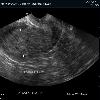

Low magnification wmicrograph Tags: Endometrial Cancer View |
Tags: Endometrial Cancer View |
The Augustin below Horn Ross should be Augustin 2004 Please see corrected graphic below Corrected graphic Tags: Endometrial Cancer View |
|||||||||
Endometrial cancer refers to several types of malignancy (cancer) which arise from the endometrium, or lining of the uterus. Endometrial cancers are the most common gynecologic cancers in the United States, with over 35,000 women diagnosed each year in the U.S. The most common subtype, endometrioid adenocarcinoma, typically occurs within a few decades of menopause, is associated with excessive estrogen exposure, often develops in the setting of endometrial hyperplasia, and presents most often with vaginal bleeding. Endometrial carcinoma is the third most common cause of gynecologic cancer death (behind ovarian (ovarian cancer) and cervical cancer). A total abdominal hysterectomy (surgical removal of the uterus) with bilateral salpingo-oophorectomy is the most common therapeutic approach.
Endometrial cancer may sometimes be referred to as uterine cancer. However, different cancers may develop not only from the endometrium itself but also from other tissues of the uterus, including cervical cancer, sarcoma (uterine sarcoma) of the myometrium, and trophoblastic disease.
Diseasesdb: 4252
Icd10: ICD10C541c51
Icd9: ICD9182
Omim: 608089
Medlineplus: 000910
Emedicinesubj: med
Emedicinetopic: 674
Emedicine Mult: eMedicine2radio253
Meshid: D016889



